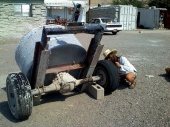Sorry, been busy these past few months.
There is a way to build a slab (or any form) with a small crew, limited equipment, limited power sources, and low water: shoot it.
Shotcrete, or gunnite, is a means of continuously applying a crete material to any combination of forms, overheads, and highwalls.
Here's a link to click on.
This is a gunnite machine. You'll need someone to bust bags or shovel material into the hopper (1), someone to handle the pot (2), someone on the nozzle (3), someone to help the nozzle guy (4), forklift operator (5).
5 people. More is better, as some of the work is brutal. Rotate them out for a break.
It's dusty. Have an ample supply of N95 particulate respirators available, plus protective wear or replacement clothing for every 4-6 hours of work.
Experience matters. The right guy on the nozzle will get the job done better while using half the material.
You will need:
-an air compressor, industrial size, 180 PSI capacity
-a gunnite machine (the Pot), these can be rented
-spare boots (rubber gaskets) for the Pot
-gunnite hoses, should be available from the Pot rental guys
-water hoses, bull (air) hoses
-spare nozzle, from the rental guys
-spare water rings, from the rental guys
-lighting if you go all day and all night
-a pressurized water source, tanker/pump/generator will be needed for off grid work
-face shields
-the material in place ready to go
-a forklift to keep the material ready to go lined up
-the site formed and prepped
-action hoe, shovels, hand tools, wheelbarrels
-fuel for the compressor, forklift, and generator, if you go that route
-rubber boots sure do come in handy
How it works:
A guy dumps material into the pot, continuously
air from the compressor moves through the pot, blowing the material through the hose
at the exit end of the hose, water sprays into the nozzle
the dry mix is combined with the water in mid air to form the crete, shoots out the nozzle
the now moist mix, hits the target and sticks
a little bit of material will rebound
the nozzle guy keeps on moving and shooting until the form is filled
This method will install about 3 tons of material per hour, continuously-no batches. Cold joints are eliminated as long as the shooter knows what he's doing and flashes over the leading edges every few minutes. The amount of rebound/waste is reduced with an experienced shooter. Finish work is done with hand tools, scraping the surfaces to the desired texture. Mind you, this is rough work. You won't get a smooth surface such as a garage floor, but you can do the finish work with minimal labor and carpentry skills. You can use local materials if they are properly prepared beforehand. The largest aggregate would be in the 1/4" range, but the purchased shotcrete mix would be able to handle whatever stresses you desire. If you want strength, heat tolerance, or abrasion resistance, the material is out there. For best results, the environment and material needs to be above 50 degrees during application.



































































